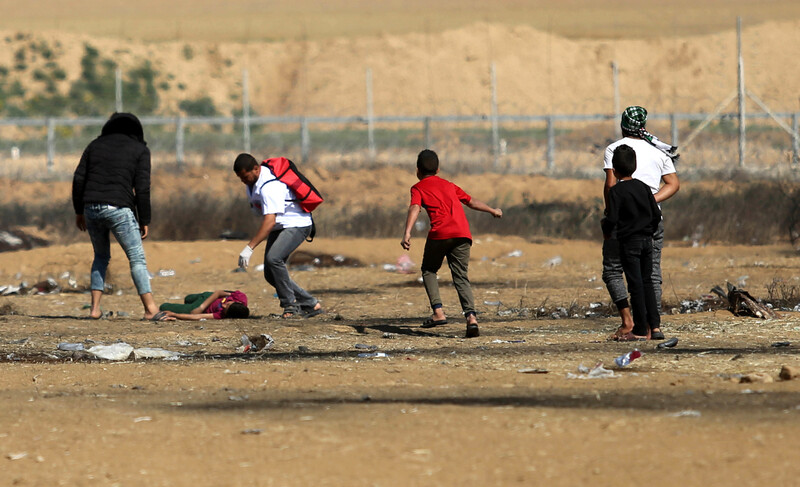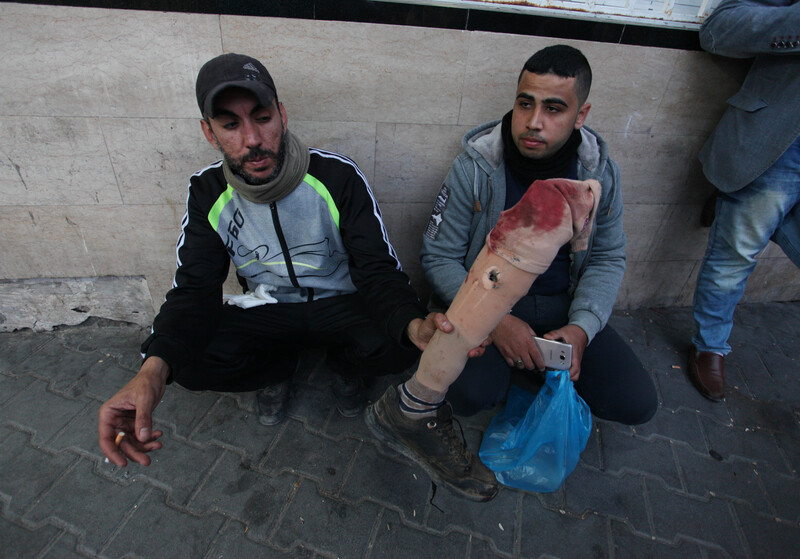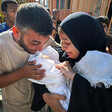Rights and Accountability 24 April 2018

A wounded Palestinian boy is evacuated during protests east of Khan Younis, southern Gaza, on 22 April.
APA imagesTwo Palestinians have died of their injuries after being wounded by Israeli soldiers during Great March of Return protests along Gaza’s eastern boundary.
Abdallah Muhammad Jibril al-Shamali, 20, died on Sunday, two days after being shot in the chest east of Rafah in southern Gaza on 20 April, the fourth consecutive Friday mass rally as part of a six-week protest set to culminate on 15 May.
Al-Shamali is the son of Muhammad Jibril al-Shamali, a leader of the Qassam Brigades, the armed wing of Hamas, who was killed in August 2009 during a massive battle between Gaza security forces and members of a group aligned with al-Qaida.
A photo of the younger al-Shamali circulated on social media after the announcement of his death:
Tahrir Mahmoud Said Wahbeh, 18, died on Monday from injuries sustained when he was shot in the head east of Khan Younis, southern Gaza, on 1 April.Wahbeh’s shooting was caught on video:
The video shows Wahbeh, who was deaf, wearing a surgical mask near burning tires along with a handful of other demonstrators. At the time of his shooting, he has his back turned to the soldiers positioned behind the Gaza boundary fence and is waving his arms in the air when he falls to the ground and a group of protesters come to his aid.The video shows that he is holding nothing in his hands and was posing no conceivable threat to any heavily armed Israeli snipers when they shot him in the head.
Wahbeh was 150-200 meters away from Gaza’s boundary with Israel when he was shot, according to the rights group Al Mezan.
A photo of Wahbeh circulated on social media after the announcement of his death:
Thirty-four Palestinians, including four children and a journalist, have been fatally wounded by Israeli forces during Great March of Return protests since 30 March. More than 1,600 Palestinians have been wounded by live fire during the protests. Nearly 140 are critically injured, Gaza’s health ministry stated on Monday.Not a single Israeli has been reported injured as a result of the protests.
Deliberate injury
Human rights groups have accused Israel of deliberately injuring and maiming Palestinian civilians during the protests.
Doctors have reported “horrific injuries” likely to leave many of them with permanent disabilities.
Protester Bilal Muhammad Masoud, 27, told the rights group Al-Haq that he was shot in the arm and both legs for placing a Palestinian flag on a fence along the boundary during a mass protest on 6 April.Soldiers prevented other Palestinians from coming to Masoud’s aid.
“Every time the youth would try to come close to me to pull me out, the soldiers would start shooting live fire and tear gas towards them so they would have to retreat,” he told Al-Haq.
Masoud lay bleeding on the ground for 20 minutes until he was able to crawl to an area where other protesters could pull him away.
Ibrahim Misbah Abd al-Al, 30, was shot in both legs while carrying injured protesters to ambulances on 30 March. His right leg was amputated as a result of his injuries.
“I was not expecting that participating in a demonstration would cost me my leg,” he told Al-Haq.
“However, the hardest of all is that I often think how I will not be able to lead my life normally after this, and how I will support my wife and children with one leg.”

A Palestinian man carries Iyad al-Dawahid’s prosthetic leg at Gaza City’s al-Shifa hospital after he was shot by Israeli forces during protests along the Israel-Gaza boundary, 6 April 2018.
APA images
Iyad al-Dawahid is taken to al-Shifa hospital for treatment after he was shot by Israeli occupation forces during protests at the Israel-Gaza boundary, 6 April.
APA imagesWhen Iyad Manar al-Dawahid, 28, was shot by two bullets in both of his legs on 6 April, Israeli soldiers “shot at anyone who approached him,” according to Al-Haq. He lay bleeding on the ground for 10 minutes before he was taken to a hospital.
One of the bullets hit al-Dawahid in his prosthetic leg, which was donated to him by Jordanian doctors after his leg was amputated due to Israeli shelling during the 51-day military offensive on Gaza in summer 2014.
Al-Dawahid can no longer use the prosthetic leg which he waited years for, “as it no longer fits his size due to the injury and damage caused by the bullet in his left leg,” Al-Haq reported.
“I have now lost the ability to receive another prosthetic limb, and therefore I am unable to move, even restrictively, while standing on my feet,” al-Dawahid told Al-Haq. “I will remain a prisoner to the wheelchair because of my injury.”
“A horrific experience”
Atef al-Areer, 50, told the Israeli human rights group B’Tselem that he was “astounded by the sheer masses of people” who attended the inaugural Great March of Return protest east of Gaza City on 30 March, which comprised a tent city encampment with women, children and elderly in attendance.
“I even saw people, especially older folks, who had brought along their ‘return keys,’ the keys they’d kept of their homes” from which they were expelled in 1948, he said.
Nearer to the boundary with Israel, however, soldiers were firing at youths who were waving flags and burning tires.
“While I was watching the protesters, I saw something horrific: Soldiers fired at a youth and hit him in the chest,” al-Areer said. “He was killed instantly. I picked him up and carried him to the ambulances that were about 50 meters away.”
Al-Areer added that “almost every shot injured or killed someone.”
While soldiers fired on protesters, drones dropped tear gas canisters “which caused severe suffocation, tearing up and fainting,” al-Areer recalled.
“I thought it was going to be a quiet gathering, but it was a horrific experience,” he said of the protest.
“The demonstrators weren’t bearing weapons. They were waving Palestinian flags and calling out slogans in praise of the homeland and also calling for peace and living in dignity.”
B’Tselem also published testimony from Aida al-Majdalawi, 63, recounting how she was shot in her left leg when she came to the aid of youths injured near the boundary fence in northern Gaza on 30 March.
“I thought that because I’m an older woman, the soldiers would let me go to the people who’d been hit and help them, but they shot me anyway,” she said.
This article was corrected to state that four children, rather than three, have been killed during the Great March of Return protests.





